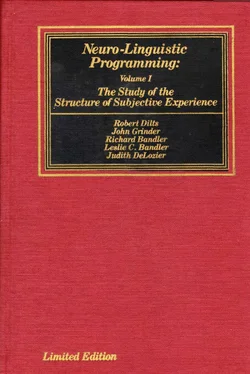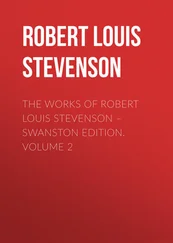NOTE: It is obvious that some of those representations that we have superscripted "e" in our representations of the 4–tuples will actually be internally generated memories at the point in time that you are eliciting them, rather than external events in the individual's ongoing environment. We have used the superscript "e" to establish the difference between what was generated internally and externally in the context or state in question, as that is very important information. Any possible mix–ups may be avoided, of course, by having the individual reproduce the effect of the experience in the ongoing context before you anchor it. For instance, you can ask, "Can you see me as clearly as you saw that other person in the situation you are talking about?"
4.32 Anchoring and Utilization.
Anchoring and accessing cues (you can think of accessing cues, incidentally, as self–established anchors), as we have said, are a means to elicit the appropriate representation or representational system at the appropriate position in the strategy. They offer an often surprisingly powerful means to influence the outcomes of strategies. If, for example, you would like someone to decide in favor of something you can ask him if he has ever made a decision that he was very sure of and that generated positive results for him. As he accesses the experience, ask him how he knew to decide in favor of the proposition (what you are asking for here is what value in the representational system is required for a positive response at the decision point in the strategy). As the person accesses the representation (it may be "Well, I said to myself…", or "I got this flash …", or "It felt right…") anchor it in whatever means is most appropriate for the situation. Later, as you are pacing the person through his decision strategy, fire off the anchor when you get to the decision point in his strategy. This will exert a great deal of influence toward a positive outcome from the strategy. Sometimes, if you get a good anchor, you can simply elicit the appropriate decision value in the person and get the outcome without the having to go through the rest of the strategy.
You can accomplish the same thing through instructions, like, " … as you continue to see that image, take a deep breath and think of a time you felt really good …" Or you can do it indirectly by presenting the content in question and then switching the subject to something that the person enjoys, so that the content you are discussing becomes associated with positive experiences.
Most classical conditioning involves the establishment or overriding of the choice value at the decision point in an animal's or a person's strategy, through external sources. This is an example of using anchoring to influence a strategy. Let's consider a Pavlov's dog example. Let's say our dog has been conditioned to push a lever for food pellets at the sound of a bell. We will hypothesize a strategy that goes:
A e→K i→V e→V i→K e→Exit
In this strategy the animal hears the bell (A e) which anchors the internal kinesthetic sensations of hunger (K i). This in turn anchors up the next step in the strategy which involves looking at the lever (V e). The dog then sees internally a replay of itself pushing the lever and receiving food (V i), and this initiates the action of doing it (K e). If an experimenter wanted to decondition this program or recondition it to avoidance, he would typically use some negative kinesthetic stimulus like an electric shock. The shock would be administered as the animal is carrying out the strategy so that it overrides the ongoing step in the strategy — let's say as
it is approaching the lever. It continues getting shocked until it assumes some other behavior. Putting in the negative anchor (the shock) will eventually reprogram the strategy so that looking at the lever may access an internal kinesthetic representation of the shock (K i) instead of the image of pushing the lever. The representation of the shock initiates the new behavior that has been anchored to it. Eventually the strategy may become streamlined to the point that the bell itself anchors the new behavior, without the other steps in the strategy. We will go into the programming and reprogramming of new strategies in the installation section of this book. In this section we are primarily concerned with the utilization of already existing strategies and experiences.
Anchoring during utilization will generally involve establishing triggers for previously occurring motivation, creativity and learning states. At the end of this section we will present a number of content examples of how strategies may be utilized in a variety of different fields, including education, business, therapy and law.
4.33 Covert Anchoring and Pacing.
Because consciousness is a limited phenomenon, there will be times when you are pacing and anchoring an individual or group overtly, within their conscious awareness, and times when you are doing it covertly, outside their span of awareness (and sometimes your own).
In overt utilization the programmer paces by making sure the client is consciously experiencing each step that he and the programmer are going through. The programmer makes them aware of the steps in their strategy and shows them how to utilize the representational sequences to achieve new behaviors.
Covert utilization involves pacing and anchoring which are performed completely or partly outside of the client's conscious attention. This type of situation tends to occur the most often naturally during utilization because it is difficult (and often a hindrance) for an individual to be consciously aware of all of the steps in their strategies — particularly if these steps have reached the level of an unconscious TOTE. Covert pacing and anchoring often lead to the most effective results because the strategy is allowed to remain an unconscious TOTE, where it is able to function more readily and swiftly without conscious interference.
Most covert work will usually take place through the client's least conscious representational system(s). That is, through the sensory channels that the person is least aware of.
Covert anchoring is something that many people have to practice to be comfortable with. Beginners often experience themselves as being "manipulative" when they first start anchoring covertly. This results in breaking their rapport with the client (the client picks up on the programmer's discomfort) and reduces the effectiveness of their work.
A good example of covert anchoring that you may wish to practice can be drawn from a demonstration that we occasionally present in our workshops. In the demonstration a subject is asked to recall a number of instances in which he has forgotten something. For instance, we may ask the following series of questions:
Can you think of a time you forgot someone's name? What was that experience like?
Can you think of what it's like to have something important right on the tip of your tongue but not be able to get it out?
What is it like when you know that you know something but just can't remember what it is?
As we observe the subject's facial expression, skin color, breathing, and tonal and tempo changes as their 4–tuples for "forgetting" come up, one of us will anchor each of them with a clearing of the throat (an A eanchor to which most people pay no conscious attention). Eventually, the subject is asked to remember something that should be readily available to him — such as his telephone number, his mother's first name, or to repeat what they just finished saying. As soon as the question is asked, however, one of us will clear his throat, triggering the strategy for forgetting. The subject will often experience an unusual and convincing amount of difficulty in the recall task. If one of us keeps clearing his throat, the individual may be unable to recall the information for extended periods of time.
Читать дальше











